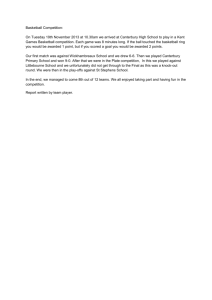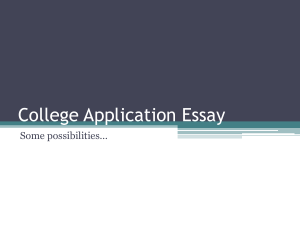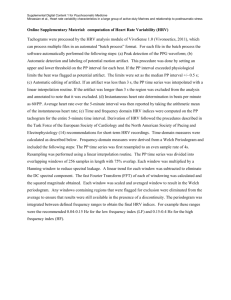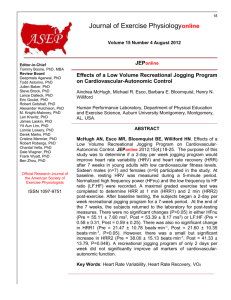Disclaimer - American Society of Exercise Physiologists
advertisement
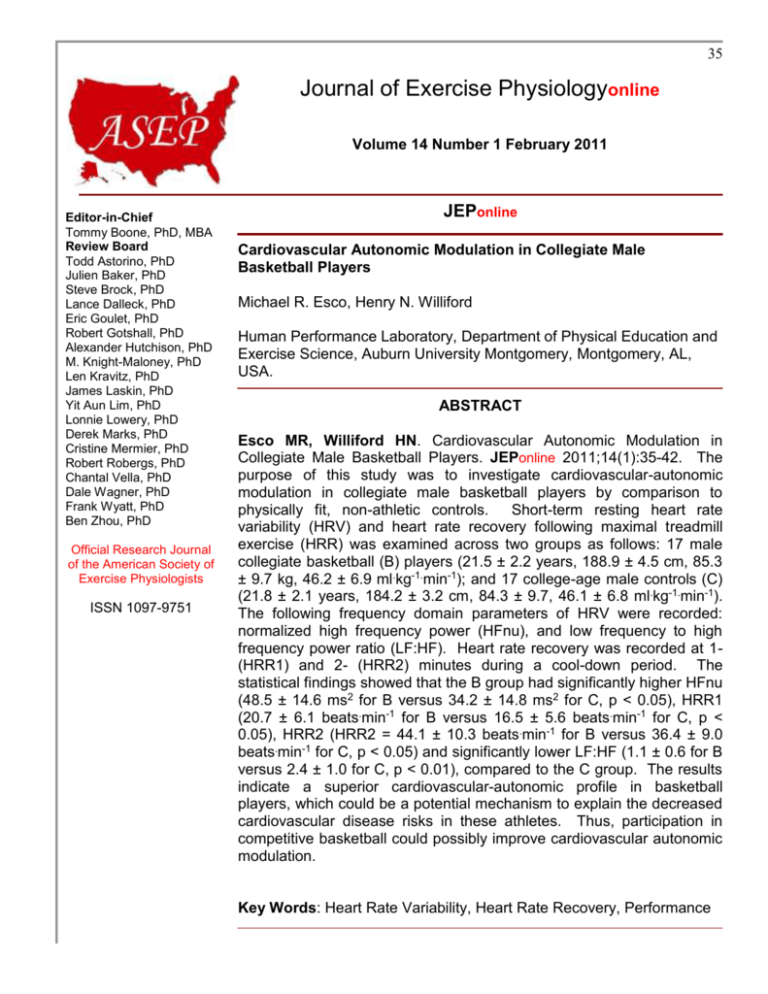
35 Journal of Exercise Physiologyonline Volume 14 Number 1 February 2011 Editor-in-Chief Tommy Boone, PhD, MBA Review Board Todd Astorino, PhD Julien Baker, PhD Steve Brock, PhD Lance Dalleck, PhD Eric Goulet, PhD Robert Gotshall, PhD Alexander Hutchison, PhD M. Knight-Maloney, PhD Len Kravitz, PhD James Laskin, PhD Yit Aun Lim, PhD Derek Marks, Lonnie Lowery, PhD PhD CristineMarks, Derek Mermier, PhDPhD Robert Robergs, Cristine Mermier,PhD PhD ChantalRobergs, Robert Vella, PhD PhD Ben Zhou, Chantal Vella, PhDPhD Dale Wagner, PhD Frank Wyatt, PhD Ben Official Zhou, Research PhD Journal of the American Society of Official Exercise Research Physiologists Journal of the American Society of Exercise Physiologists ISSN 1097-9751 ISSN 1097-9751 JEPonline Cardiovascular Autonomic Modulation in Collegiate Male Basketball Players Michael R. Esco, Henry N. Williford Human Performance Laboratory, Department of Physical Education and Exercise Science, Auburn University Montgomery, Montgomery, AL, USA. ABSTRACT Esco MR, Williford HN. Cardiovascular Autonomic Modulation in Collegiate Male Basketball Players. JEPonline 2011;14(1):35-42. The purpose of this study was to investigate cardiovascular-autonomic modulation in collegiate male basketball players by comparison to physically fit, non-athletic controls. Short-term resting heart rate variability (HRV) and heart rate recovery following maximal treadmill exercise (HRR) was examined across two groups as follows: 17 male collegiate basketball (B) players (21.5 ± 2.2 years, 188.9 ± 4.5 cm, 85.3 ± 9.7 kg, 46.2 ± 6.9 ml.kg-1.min-1); and 17 college-age male controls (C) (21.8 ± 2.1 years, 184.2 ± 3.2 cm, 84.3 ± 9.7, 46.1 ± 6.8 ml.kg-1.min-1). The following frequency domain parameters of HRV were recorded: normalized high frequency power (HFnu), and low frequency to high frequency power ratio (LF:HF). Heart rate recovery was recorded at 1(HRR1) and 2- (HRR2) minutes during a cool-down period. The statistical findings showed that the B group had significantly higher HFnu (48.5 ± 14.6 ms2 for B versus 34.2 ± 14.8 ms2 for C, p < 0.05), HRR1 (20.7 ± 6.1 beats.min-1 for B versus 16.5 ± 5.6 beats.min-1 for C, p < 0.05), HRR2 (HRR2 = 44.1 ± 10.3 beats.min-1 for B versus 36.4 ± 9.0 beats.min-1 for C, p < 0.05) and significantly lower LF:HF (1.1 ± 0.6 for B versus 2.4 ± 1.0 for C, p < 0.01), compared to the C group. The results indicate a superior cardiovascular-autonomic profile in basketball players, which could be a potential mechanism to explain the decreased cardiovascular disease risks in these athletes. Thus, participation in competitive basketball could possibly improve cardiovascular autonomic modulation. Key Words: Heart Rate Variability, Heart Rate Recovery, Performance 36 INTRODUCTION Physical exertion challenges the autonomic nervous system’s (ANS) control of the cardiovascular system. For instance, at rest, the heart’s activity is primarily regulated by the parasympathetic vagal branch of the ANS. During exercise, the increase in heart rate and stroke volume to meet the metabolic demands of active skeletal muscles has two phases: a rapid tachycardia due to vagal withdrawal followed by sympathetic dominance (10). Immediately following a bout of exercise, heart rate decays toward a resting level primarily due to sympathetic withdrawal subsequent to the return of vagal activity (6,9,14). Heart rate recovery (HRR) following exercise and resting heart rate variability (HRV) are two noninvasive tools used to evaluate ANS function. While traditionally assessed in clinical settings due to their relationships with cardiovascular disease and sudden death (8,15,19,21,22,24), HRR and HRV have important implications for understanding strength and conditioning. They have been shown to predict aerobic fitness, are beneficial in exercise prescription, can assist with evaluating the outcomes of exercise training, and are able to predict incidences of overtraining (4,13,14,16-18). It is accepted that participation in athletic sports improves physical fitness and decreases the risk of cardiovascular disease and mortality (2). One reason for this is that exercise conditioning improves the actions of the ANS, thus enhancing HRR and HRV (2,23). Most of the research in this area is focused on aerobic and endurance trained individuals or programs, suggesting that an improved aerobic fitness level is related to faster HRR and enhanced HRV indexes (2). However, research examining cardiovascular-autonomic profile in athletes whose sport involves a mixed metabolic contribution from aerobic and anaerobic energy systems, such as basketball, has not been fully explored. Therefore, the purpose of this study was to investigate HRV at rest and HRR after maximal exercise in collegiate male basketball players by comparison to physically fit, non-athletic controls. The basketball athletes and controls were matched for maximal aerobic fitness. Due to this matching, it was hypothesized that there would be no significant difference in HRR or HRV between the athletes and controls. METHODS Subjects Participants were recruited from the University’s National Association for Intercollegiate Athletics (NAIA) basketball team, physical education classrooms, and by word of mouth. There were 17 male basketball players (B group) and 17 male physically active subjects (C group) who volunteered for this study, which was approved by the University’s Institutional Review Board for research involving human subjects. Descriptive statistics are presented in Table 1. All data were collected on one visit to the laboratory. Each subject provided appropriate written informed consent. All of the subjects were apparently healthy, free from cardiopulmonary, metabolic, and/or orthopedic disorders, and were not taking any prescription or over-the-counter medications. Before each visit to the laboratory, the subjects were instructed to not consume alcoholic beverages or sympathomimetic agents 12 hours prior to testing, to not eat at least 3 hours prior to testing, and to avoid vigorous exercise for at least 24 hours prior the testing procedures. After the screening procedures, each subject had height (to the nearest 0.1 cm) measured with a wall mounted stadiometer (SECA) and body weight (to the nearest 0.1 kg) measured with a digital scale (TANITA BWB-800A). Body mass index (BMI) was calculated from the data as weight divided by height squared (kg.m-2). Then, body fat percentage was estimated via the 7-site skinfold method as described by written standards (1). 37 Procedures Heart Rate Variability For HRV analysis, each subject was instructed to lay supine on an athletic training table in a dimly lit climate controlled laboratory for a 10-minute period. During this time, the subject’s heart rate was assessed via electrocardiography (ECG). Three Ag/AgCl electrodes were placed on the across the subject’s torso in a Lead II configuration. The electrodes were interfaced with a Biopac MP100 data acquisition system (Goletta, CA) and all data were stored in a Dell PC for analysis. All HRV analyses were carried out during the last 5-minute epoch of the ECG, in accordance with written guidelines for HRV assessment (25). The frequency domain analysis of HRV was used because of its ability to accurately assess HRV during short-term recordings (25). Specialized HRV software (Nevrokard version 11.0.2, Izola, Slovenia) was used to transform the ECG into a power spectrum via fast Fourier transformation. High frequency component of the power spectrum (0.15 – 0.40 Hz) was normalized (HFnu) and recorded. The low frequency to high frequency ratio (LF:HF) was recorded and included in the data analysis. The HFnu was used to represent parasympathetic modulation, while the LF:HF was used to represent sympathetic to parasympathetic balance (25). Maximal Oxygen Consumption (VO2 max) After the HRV measures were complete, each subject performed a maximal graded exercise test on a treadmill (Parker Co., Opelika, AL) via the Bruce protocol. During each exercise test a series of 3minute stages with progressively increased workloads was performed until the subjects achieved VO 2 max. Maximal oxygen consumption was reached if two of the following criteria occurred: a plateau in VO2 with increasing work rate; RER > 1.15; heart rate within 10 beats of age predicted maximum (220 – age); or volitional fatigue. Once the subject achieved VO 2 max, a 3-minute cool-down period was allowed with the speed of the treadmill decreased to 2.5 mph at a 1.5% grade. During the test, an Applied Electrochemistry (AMETEK, Pittsburg, PA) metabolic analyzer was used to continuously measure the concentration of expired gases (oxygen and carbon dioxide) with a pneumotach. Data was recorded every 30-seconds using Turbofit 5.06 software (VACUMED, Ventura, CA) and stored on a personal computer for analysis. Heart Rate Recovery Heart rate was monitored continuously during the exercise test with ECG. Maximal heart rate (MHR), and the heart rates at 1- and 2-minutes of the cool-down period were recorded. The heart rates at the 1-minute and the 2-minute cool-down were subtracted from MHR to represent the 1-minute (HRR1) and the 2-minute (HRR2) heart rate recovery, respectfully. Statistical Analyses Subject data were entered into SPSS 16.0 for statistical analysis. Means (± SD) were determined separately for each group for the following descriptive statistics: age (years), height (cm), weight (kg), BMI (kg.m-2), predicted percent body fat (%), and VO2 max (ml . kg-1 . min-1). A one-way analysis of variance (ANOVA) was used to compare group differences in HRR1, HRR2, HFnu, and LF:HF. Statistical significance for all tests was set at p < 0.05. RESULTS There were no significant differences in the descriptive statistics found between the B and C groups (Table 1). Figures 1 and 2 represent the mean differences in the HRR and HRV variables between the groups. The values for HRR1, HRR2, HFnu, and LF:HF between the two groups were as follows: HRR1 = 20.7 ± 6.1 beats.min-1 for B, 16.5 ± 5.6 beats.min-1 for C (p < 0.05, Figure 1), HRR2 = 44.1 ± 10.3 beats.min-1 for B, 36.4 ± 9.0 beats.min-1 for C (p < 0.05, Figure 1), HFnu = 48.5 ± 14.6 ms2 for B, 38 Table 1. Descriptive statistics (Mean ± SD) for the basketball players (B) and control group (C). B (n = 17) C (n = 17) 21.5 ± 2.2 21.8 ± 2.1 Height (cm) 188.9 ± 4.5 188.9 ± 4.5 Weight (kg) 85.3 ± 9.7 84.3 ± 9.7 BMI (kg.m-2) 23.9 ± 2.2 24.0 ± 3.0 7.5 ± 3.1 8.3 ± 3.9 46.2 ± 6.9 46.1 ± 6.8 Age (yrs) BF (%) . -1. -1 VO2max (ml kg min ) 34.2 ± 14.8 ms2 for C (p < 0.01, Figure 2), and LF:HF = 1.1 ± 0.6 for B, and 2.4 ± 1.0 for C (p < 0.01, Figure 2). According to the one-way ANOVA, the cardiovascular-autonomic measures were significantly different between the groups. The 1-minute (HRR1), 2-minute (HRR2), and normalized high frequency power (HFnu) were significantly higher and the low frequency to high frequency power ratio (LF:HF) was significantly lower in B compared to C (p < 0.05). DISCUSSION Heart rate recovery and HRV are two noninvasive methods that are commonly used to evaluate parasympathetic and sympathetic influence to the cardiovascular system. The primary interest of both variables is their prognostic value of predicting premature cardiovascular disease and sudden cardiovascular death (8,14,24). However, they are now being assessed in applied settings related to strength and conditioning and exercise physiology due to their ability to monitor exercise training status (4,5,14,17,18). The purpose of this study was to compare HRR and HRV between collegiate male basketball players to physically active controls. The results indicate that the basketball players have a superior cardiovascular-autonomic profile. Since HRV and HRR are non-invasive predictors of premature cardiovascular disease, the results support previous research showing lower cardiovascular disease risks in athletes compared to non-athletes (2,23). 60 * 25 HRR2 (beats.min-1) HRR1 (beats.min-1) 30 20 15 10 5 0 * 50 40 30 20 10 0 B C Group B C Group Figure 1. The heart rate recovery values between the basketball players (B) and control group (C). HRR1 = 1-minute heart rate recovery; HRR2 = 2-minute heart rate recovery. *HRR1 and HRR2 were significantly higher in B compared to C (p < 0.05). 39 The findings of increased autonomic regulation in athletes have been previously reported. In comparison to non-athletes, many studies have shown HRV and HRR to be higher and faster, respectfully, primarily in endurance trained athletes (2,11,23,25). For example, the results of an early cross-sectional study (11) found that 24-hour HRV was greater in endurance-trained men (VO2 max > 55 ml . kg-1 . min-1) compared to untrained men (VO2 max < 40 ml . kg-1 . min-1). In another study, Shin et al. (23) compared ANS activity between long distance athletes and sedentary controls. They found significantly higher HF power in the athletes (23). Anaerobically trained athletes have also been shown to have superior HRV and HRR profiles compared to sedentary subjects. In addition, evidence is available to suggest no significant differences in either HRR (20) or HRV (3,25) between endurance and strength trained athletes. The athletes in the abovementioned studies appear to also have lower resting heart rates and higher VO2 max values compared to their counterparts. An interesting finding of the current investigation is that there was no significant difference in VO2 max, or any other descriptive statistic that is independently related to ANS function, such as resting heart rate and body fat percentage. However, the B group had significantly better values of cardiovascular-autonomic modulation (i.e., higher HRR1, HRR2, and HFnu, and lower LF:HF). Due to these findings, perhaps, there are other physical fitness factors related to basketball participation not accounted for in the present study that may lead to improved ANS control of the cardiovascular system. 4 * 60 3.5 50 3 40 2.5 LF:HF HFnu (ms2) 70 30 20 2 * 1.5 1 10 0.5 0 0 B C Group B C Group Figure 2. The heart rate variability (HRV) parameters between the basketball players (B) and control group (C). HFnu = high frequency power of HRV; LF:HF = high frequency power to low frequency power of HRV. HFnu was significantly higher while LF:HF was significantly lower in B compared to C (p < 0.05). One possible explanation of the findings in the present study may be due to the type of training that basketball players are typically exposed to. The physiological requirements of basketball are met by aerobic and anaerobic metabolic pathways (19). However, the activities that comprise the crucial components of the game are short, interval bouts of movement, which are primarily anaerobic (12). These activities (such as explosive jumping and sprinting down the court are followed by periods of lower intensity and recovery) make basketball participation similar to high intensity interval training. At the onset of physical exertion, there is a shift in the ANS toward sympathetic dominance. 40 Immediately at the cessation of an intense bout of activity, or a drastic decrease in intensity, heart rate returns toward resting levels due to a prompt return of vagal tone. When repeated bouts of exertion are interspersed with periods of moderately intense activity over an extended period, such as during a basketball game or practice, the ANS must continually make adjustments to control the heart’s activity. Thus, it seems reasonable that the type of repetitive activity that is pivotal to basketball performance, (i.e., intense intermittent anaerobic bouts), leads to significant improvements in cardiovascular-autonomic modulation. The cross-sectional nature of the current study limits the ability to extrapolate the findings to hypothetical results from long-term training protocols. However, other investigators have shown improvements in ANS function following interval-based training. For instance, post-exercise parasympathetic reactivation was shown to be improved in adolescents following a 9-week high intensity interval training protocol that consisted of 15- to 20-second running intervals at 95% of maximal speed, followed by equal time periods of rest (6). In the same study, repeated sprints ability was significantly correlated with HRR (6). Due to these findings, along with the current study, it appears that interval training leads to improvements within the interaction between the autonomic and cardiovascular systems that may be superior to continuous, traditional endurance training. Obviously, further research is needed to fully address this theory. Moreover, previous investigators have shown overall physical activity to impact HRR and HRV. For instance, Buchheit and Gindre (7) found that training load was significantly related to cardiovascular autonomic control in middle-aged individuals. Thus, once again, it is reasonable that the findings of the study could also be related to a greater training load found in the athletes. Participation in competitive collegiate basketball typically involves conditioning and practice on multiple days of the week throughout the year (15). In addition, it should be noted that the basketball players in the present study had mean aerobic fitness values that were within approximately the 50th percentile for college-age subjects (1). Still, more research is warranted for the comparison basketball players to athletic groups who are primarily aerobic and/or primarily anaerobic. CONCLUSIONS Heart rate variability and HRR are two non-invasive assessments of autonomic nervous control of the cardiovascular system. Recently, both techniques have become popular in the assessment of cardiovascular changes that occur with physical training in field settings. Evaluating cardiovascular autonomic function of the heart via HRV and HRR provides the practitioner with information concerning how well athletes adapt to various conditioning programs. While exercise has been shown to improve both variables, the specific type of training that best enhances ANS influence is not fully known. The findings of this investigation suggest HRV and HRR are superior in college basketball players compared to healthy men who were matched for aerobic fitness, age, body fat percentage, and BMI. Basketball players typically have lower cardiovascular disease risks compared to the general population. Therefore, a potential mechanism responsible for this benefit could be due to better ANS control of the heart. At any rate, participation in basketball, especially at the competitive collegiate level, could possibly improve cardiovascular autonomic modulation. 41 Address for correspondence: Esco MR, Ph.D., Auburn University Montgomery, Department of Physical Education and Exercise Science/Human Performance Laboratory, P.O. Box 244023, Montgomery, AL, USA, 36124-4023. (334) 244-3161, (334) 244-3198; mesco@aum.edu. REFERENCES 1. American College of Sport’s Medicine. ACSM’s Guidelines for Exercise Testing and Prescription, 8th ed. Philadelphia, PA: Wolters Kluwer, 2010. 2. Aubert AE, Seps B, Beckers F. Heart rate variability in athletes. Sports Med 2003;33:889-919. 3. Berkoff DJ, Cairns CB, Sanchez LD, Moorman CT. Heart rate variability in elite American track-and-field athletes. J Strength Cond Res 2007;21:227-231. 4. Borresen J, Lampert MI. Autonomic control of heart rate during and after exercise: measurements and implications for monitoring training status. Sports Med 2008;38:633-646. 5. Buchheit M, Chivot A, Parouty J, Mercier D, Al Haddad H, Laursen PB, Ahmaidi S. Monitoring endurance running performance using cardiac parasympathetic function. Eur J Appl Physiol 2010;108:1153-1167. 6. Buchheit M, Millet GP, Parisy A, Pouchez S, Laursen PB, Ahmaidi S. Supramaximal training and postexercise parasympathetic reactivation in adolescents. Med Sci Sports Exerc 2008;40:362-371. 7. Buchheit M, Gindre C. Cardiac parasympathetic regulation: respective associations with cardiorespiratory fitness and training load. Am J Physiol Heart Circ Physiol 2006;29:H451H458. 8. Cole CR, Blackstone EH, Pashkow FJ, Snader CE, Lauer MS. Heart-rate recovery immediately after exercise as a predictor of mortality. N Engl J Med 1999;341:1351-1357. 9. Goldberger JJ, Kiet Le F, Lahiri M, Kannankeril PJ, Ng J, Kadish AH. Assessment of parasympathetic reactivation after exercise. Am J Physiol Heart Circ Physiol 2006;290:H2446-H2452. 10. Goldsmith RL, Bloomfeld DM, Rosenwinkel ET. Exercise and autonomic function. Coron Art Dis 2000;11:129-135. 11. Goldsmith RL, Bigger JT, Steinman RC, Fleiss JL. Comparison of 24-hour parasympathetic activity in endurance-trained and untrained young men. J Am Coll Cardiol 1992;20:552-558. 12. Hoffman JR, Epstein S, Einbinder M, Weinstein Y. The influence of aerobic capacity on anaerobic performance and recovery indices in basketball players. J Strength Cond Res 1999;13:407-411. 13. Hynynen E, Uusitalo A, Konttinen N, Rusko H. Cardiac autonomic responses to standing up and cognitive task in overtrained athletes. Int J Sports Med 2008;29:552-558. 42 14. Imai K, Sato H, Hori M, Kusuoka H, Ozaki H, Yokoyama H, Takeda H, Inoue M, Kamada T. Vagally mediated heart rate recovery after exercise is accelerated in athletes but blunted in patients with chronic heart failure. J Am Coll Cardiol 1994;24:1529-1535 15. Javorek IS. Yearly plan of preparation for basketball and volleyball conditioning. Strength Cond 1995;17:68-72. 16. Kiviniemi AM, Hautala AJ, Kinnunen H, Nissilã J, Virtanen P, Karjalainen J, Tulppo MP. Daily exercise prescription based on HR variability among men and women. Med Sci Sports Exerc 2010;42:1355-1363. 17. Kiviniemi AM, Hautala AJ, Kinnunen H, Tulppo MP. Endurance training guided individually by daily heart rate variability measurements. Eur J Appl Physiol 2007;101:743-751. 18. Kiviniemi AM, Tulppo MP, Wichterle D, Hautala AJ, Tiinanen S, Seppanen T, Makikallio TH, Huikuri HV. Novel spectral indexes of heart rate variability as predictors of sudden and nonsudden cardiac death after an acute myocardial infarction. Ann Med 2007;39:54-62. 19. Ostojic SM, Mazic S, Dikic N. Profiling in basketball: Physical and physiological characterstics of elite players. J Strength Cond Res 2006;20:740-744. 20. Otsuki T, Maeda S, Iemitsu M, Saito Y, Tanimura Y, Sugawara J, Ajisaka R, Miyauchi T. Postexercise heart rate recovery accelerates in strength-trained athletes. Med Sci Sports Exerc 2007;39:365-370. 21. Ponikowski P, Anker SD, Chua TP, Szelemej R, Piepoli M, Adamopoulos S, Webb-Peploe K, Harrington D, Banasiak W, Wrabec K, Coats AJ. Depressed heart rate variability as an independent predictor of death in chronic congestive heart failure secondary to ischemic or idiopathic dilated cardiomyopathy. Am J Cardiol 1997;79:1645-1650. 22. Rosenwinkel ET, Bloomfield DM, Arwady MA, Goldsmith RL. Exercise and autonomic function in health and cardiovascular disease. Cardiol Clin 2001;19:369-387. 23. Shin K, Minamitani H, Onishi S, Yamazaki H, Lee M. Autonomic differences between athletes and nonathletes: spectral analysis approach. Med Sci Sports Exerc 1997;29:1482-1490. 24. Task Force of the European Society of Cardiology and The North American Society of Pacing and Electrophysiology. Heart rate variability. Standards of measurement, physiological interpretation, and clinical use. Circulation 1996;93:1043-1065. 25. Sztajizel J, Jung M, Sievert K, Bayes De Luna A. Cardiac autonomic profile in different sports disciplines during all-day activity. J Sports Med Phys Fitness 2008;48:495-501. Disclaimer The opinions expressed in JEPonline are those of the authors and are not attributable to JEPonline, the editorial staff or the ASEP organization.

